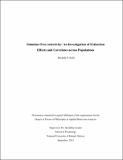| dc.contributor.advisor | Leader, Geraldine | |
| dc.contributor.author | Kelly, Michelle Patricia | |
| dc.date.accessioned | 2013-03-07T15:19:50Z | |
| dc.date.available | 2013-03-07T15:19:50Z | |
| dc.date.issued | 2012-09-19 | |
| dc.identifier.uri | http://hdl.handle.net/10379/3282 | |
| dc.description.abstract | This thesis examined stimulus over-selectivity, a phenomenon where only a limited subset of the total number of stimuli present during discrimination learning controls behaviour. Stimulus over-selectivity is a widely acknowledged problem for an individual's functioning because it limits learning in situations consisting of multiple and complex cues. This research experimentally demonstrated over-selectivity in both clinical and non-clinical populations, using a discrete trial discrimination paradigm. It investigated the remediating effects of stimulus over-selectivity by manipulating post-learning behaviour by extinguishing the over-selected stimuli. This research examined the correlation between stimulus over-selectivity and several variables, including: attention, cognitive flexibility, behavioural flexibility, stereotyped behaviour, IQ, mental age, chronological age, and severity of autism diagnosis. Chapters 2 and 3 investigated stimulus over-selectivity in children and adolescents with Autistic Spectrum Conditions (ASC). Chapter 2 examined the effects of level of functioning on degree of over-selective responding. Extinction was investigated as a potential remediation strategy for stimulus over-selectivity. Chapter 3 explored the correlation between stimulus over-selectivity and inflexibility, attention, and stereotyped behaviour to extend the theoretical framework of the concept. Chapter 4 examined stimulus over-selectivity in typically developing children aged three to seven years. An extinction procedure was employed to test the effects on the previously over-selected and under-selected stimuli, and to evaluate its potential to act as an effective remediation strategy. Chapter 4 also investigated correlations between cognitive flexibility and selective attention with over-selectivity in this non-clinical population. In Chapter 5, extinction was employed to demonstrate its effects on post-test levels of over-selectivity in three age groups of typically developing elderly individuals. This chapter also analysed chronological age, cognitive flexibility and attention levels as correlates of over-selectivity. The results from the current thesis are discussed in terms of theoretical perspectives of stimulus over-selectivity, and implications for potential remediation strategies. | en_US |
| dc.rights | Attribution-NonCommercial-NoDerivs 3.0 Ireland | |
| dc.rights.uri | https://creativecommons.org/licenses/by-nc-nd/3.0/ie/ | |
| dc.subject | autism | en_US |
| dc.subject | Attention deficit theory | en_US |
| dc.subject | Comparator theory | en_US |
| dc.subject | Autism | en_US |
| dc.subject | Extinction | en_US |
| dc.subject | Stimulus over-selectivity | en_US |
| dc.title | Stimulus Over-selectivity: An Investigation of Extinction Effects and Correlates across Populations | en_US |
| dc.type | Thesis | en_US |
| dc.contributor.funder | Write-Up Bursary of the College of Arts, Social Sciences, & Celtic Studies | en_US |
| dc.contributor.funder | Galway Doctoral Research Fellowship of the College of Arts, Social Sciences, & Celtic Studies | en_US |
| dc.local.note | This thesis examined stimulus over-selectivity, a phenomenon where only a limited number of the total stimuli present during learning controls behaviour. This thesis investigated extinction, a potential remediation strategy for stimulus over-selectivity, in both clinical and non-clinical populations. | en_US |
| dc.local.final | Yes | en_US |
| nui.item.downloads | 894 | |


